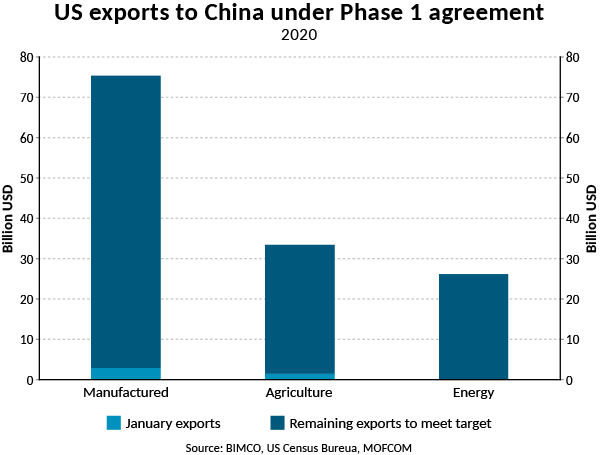Even before the effects of the coronavirus, the ‘Phase One' agreement between China and the US failed to boost volumes of the implicated goods in January.
In fact, exports of the manufactured, agricultural and energy goods included in the deal were down 26% from January 2017, which serves as the base year for the agreement.
The ‘Phase One' agreement which was signed on 15 January 2020 to lowered some US tariffs on imports from China, which in return has committed to increase its imports from the US. The widely discussed USD 200 billion deal is divided over two years and across four sectors: manufacturing, agriculture, energy and services. Exports of these goods from the US to China are set to rise by USD 200 billion compared with levels in 2017.
“The Phase One agreement brought some relief to the shipping market as a further deterioration of the relationship between the US and China was avoided,” says Peter Sand, BIMCO's Chief Shipping Analyst.
“For the extra volumes to be met, exports in January needed to show strong growth. This failed to happen. In fact with the fall in volumes, January represented a backwards step from the starting line, rather than a strong start to the year, meaning even more ground has to be covered in the remaining months of the year,” Sand says.

730% growth in energy exports needed to meet the goal
Based on the agreement, US exports of the manufactured goods should rise to USD 75.4 billion in 2020, up from USD 40.8 billion in 2019, representing an 86% growth rate. While this growth rate is already high, it shadows in comparison to the 126% growth needed for agricultural exports to rise from USD 14.7 billion in 2019 to USD 33.4 billion in 2020, let alone the 730% growth needed to increase energy exports to meet the goal of USD 26.1 billion this year from just USD 3.1 billion last year.
With only a year to meet growth targets of this magnitude, every month counts and strong growth is needed right from the start of the year and in this respect, January has disappointed. In particular, energy imports fell dramatically to just USD 25.7 million, less than 0.1% of the USD 26.1 billion commitment from China for the full year, and just under half of exports in January 2017, the level which has to be consistently beaten by quite a margin in every month this year.
January has disappointed; strong growth is needed from the get go
US exports of the manufactured and agricultural goods under the deal showed a smaller reduction in January 2020 compared to January 2017 than the energy exports, but still a decline of 1.6% and 43.3% respectively. Exports in January for both of these categories of goods were around 4% of the total exports needed if the commitments are to be met.
The low exports in January cannot be attributed to the coronavirus outbreak, as this had only a very limited impact on the Chinese economy in January and no effect on its trade with the US. The virus has however plagued exports in February, and will continue to do so in the coming months, even as China slowly returns to work. In reality, this means that exports in the first quarter of the year are unlikly to deliver any growth, let alone the high rates needed to meet the commitments in the agreement. It is highly unlikely that the next three quarters of the year will see exports on track to meet the target, let alone to make up for missing volumes in the first quarter.
Dificulties ahead
Agricultural goods, such as soya beans, need to be planted in the coming months, with soya bean farmers in the US now facing the decision of what to plant for the coming harvest. Having been burnt several times before over the course of the trade war, their willingness to plant the huge volumes needed to meet the potential additional demand remains questionable.
Furthermore, the sudden drop in the oil price following the breakup of the OPEC+ alliance means that volume growth in the energy exports will have to be even higher than the value figures suggest, as each tonne of crude oil is now worth considerably less than it was just a week ago, let alone 2017.
“Developments across the globe since the agreement was signed in mid-January, from the coronavirus outbreak to the falling oil price have made it even less likely that China and the US will be able to live up to their commitments and thereby help boost demand for the shipping industry. If the agreement is to make sense, a revision may be needed when the dust has settled around the coronavirus disruptions and there is once again room to focus on trade policies,” says Peter Sand.
Source: BIMCO